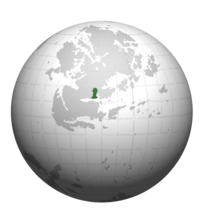Bergenaria: Difference between revisions
Jump to navigation
Jump to search
mNo edit summary |
mNo edit summary |
||
| (2 intermediate revisions by 2 users not shown) | |||
| Line 8: | Line 8: | ||
|englishmotto = ''Equality in Justice'' | |englishmotto = ''Equality in Justice'' | ||
|national_anthem = "¡Oíd, mortales!, el grito sagrado!" | |national_anthem = "¡Oíd, mortales!, el grito sagrado!" | ||
|image_map = File:Bergenaria in Europa.png | |image_map = [[File:Bergenaria in Europa.png|200px]] | ||
|capital = [[Serenno]] | |capital = [[Serenno]] | ||
|official_languages = {{wp|Spanish language|Stillian}} '' | |official_languages = {{wp|Spanish language|Stillian}} ''{{wp|de facto}}'' | ||
|recognized_languages = Stillian and [[Languages of Bergenaria|12 Aromatic]] languages | |recognized_languages = Stillian and [[Languages of Bergenaria|12 Aromatic]] languages | ||
|ethnic_groups = Bergenaran, Anirians, and [[Ethnic groups in Bergenaria|other diverse groups]]. | |ethnic_groups = Bergenaran, Anirians, and [[Ethnic groups in Bergenaria|other diverse groups]]. | ||
|religion = 88.9% | |religion = | ||
* 88.9% {{wp|Christianity}} | |||
** 77.7% {{wp|Catholic Church|Roman Catholic}} | |||
8.1% | ** 11.2% {{wp|Protestantism}} | ||
0.2% Others | * 8.1% {{wp|Irreligion|Irreligious}} | ||
2.5% Unaffiliated (believer) | * 0.2% Others | ||
* 2.5% Unaffiliated (believer) | |||
|demonym = Bergenaro, Bergenario. | |demonym = Bergenaro, Bergenario. | ||
|government_type = Federal parliamentary constitutional monarchy | |government_type = Federal parliamentary constitutional monarchy | ||
| Line 62: | Line 63: | ||
|currency = {{wp|Spanish peseta|Bergenarian real (BGR)}} | |currency = {{wp|Spanish peseta|Bergenarian real (BGR)}} | ||
|currency_code = {{wp|ISO 4217|ISO 4217}} | |currency_code = {{wp|ISO 4217|ISO 4217}} | ||
|time_zone = | |time_zone = {{wp|Coordinated_Universal_Time#Time_zones|UTC}}+6 {{wp|Coordinated_Universal_Time#Time_zones|UTC}} +7 | ||
|date_format = dd-mm-yyyy | |date_format = dd-mm-yyyy | ||
|drives_on = right | |drives_on = right | ||
| Line 69: | Line 70: | ||
}} | }} | ||
[[Category:Bergenaria]] | [[Category:Bergenaria]] | ||
Latest revision as of 08:53, 22 May 2023
Bergenaria Reino Federal de Bergenaria | |
|---|---|
| 'Motto: 'Equidad en la Justicia Equality in Justice | |
| Anthem: "¡Oíd, mortales!, el grito sagrado!" | |
 | |
| Capital | Serenno |
| Official languages | Stillian de facto |
| Recognized languages | Stillian and 12 Aromatic languages |
| Ethnic groups | Bergenaran, Anirians, and other diverse groups. |
| Religion |
|
| Demonym(s) | Bergenaro, Bergenario. |
| Government | Federal parliamentary constitutional monarchy |
| Clemente VIII | |
| Sonia Almenares | |
| Legislature | Congreso Nacional |
| Senate | |
| Chamber of Deputies | |
| Unification | |
• Collapse of the Holy Bergenaran Empire | 12 September 1834 |
• Consumation of the Revolución Liberal | 18 September 1834 |
• Start of the Revolución del Cempasuchil | 2 November 1867 |
• Proclamation of the Kingdom | 1 January 1873 |
• Two Thousand Days War | 21 November 1948 |
• Current constitution | 29 December 1971 |
| Area | |
• Total | 238,900 km2 (92,200 sq mi) |
| Population | |
• 2020 census | 29,000,000 |
• Density | 121.3/km2 (314.2/sq mi) |
| GDP (PPP) | 2020 estimate |
• Total | $439,350 million |
| GDP (nominal) | 2020 estimate |
• Per capita | $15,150 |
| Gini (2016) | 33.0 medium |
| HDI (2019) | 0.904 very high |
| Currency | Bergenarian real (BGR) ([[Wikipedia:ISO 4217|ISO 4217]]) |
| Time zone | UTC+6 UTC +7 |
| Date format | dd-mm-yyyy |
| Driving side | right |
| Calling code | +34 |
| Internet TLD | .ber |

